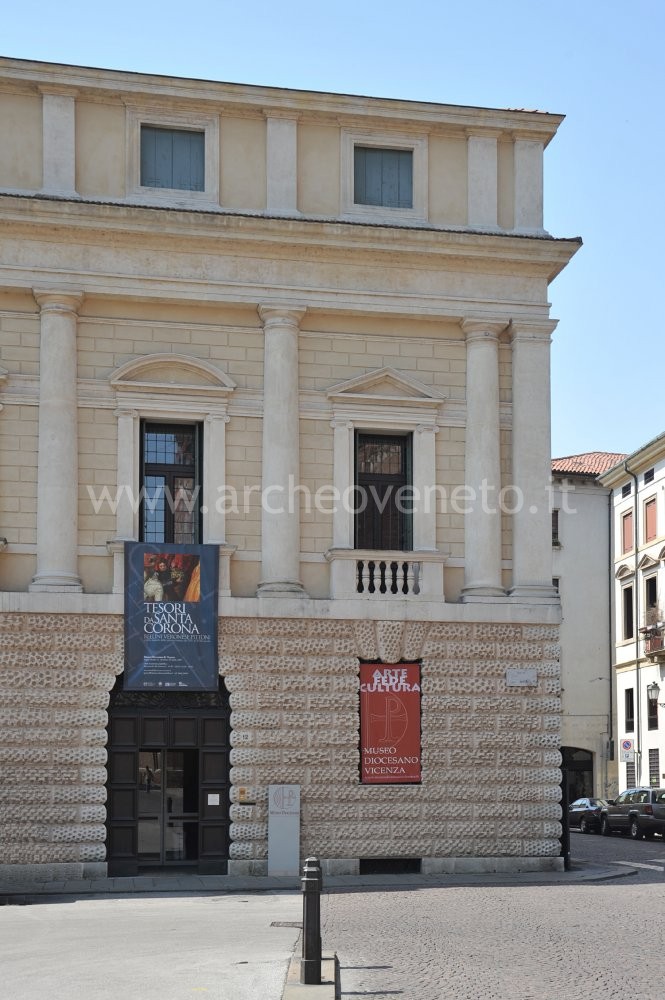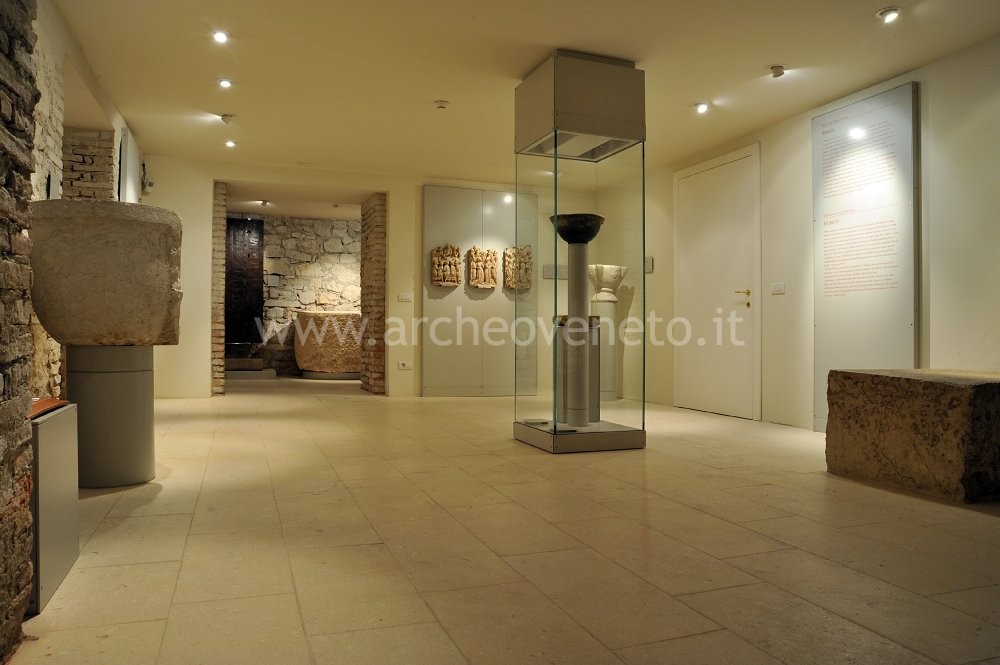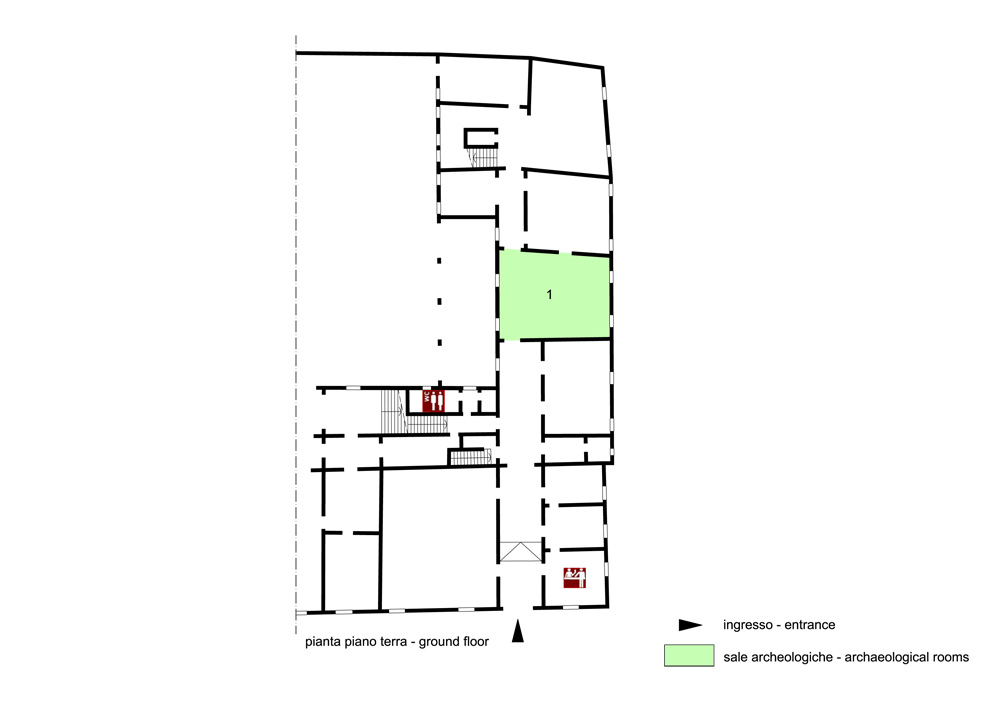|
|
File
Diocesan Museum – Vicenza
|
Piazza Duomo 12 – 36100 Vicenza (VI)
– Fax 0444 226404 |
  |
|
Summary

The Diocesan Museum was set up in 2005 in the halls of the Bishop’s Palace. The museum is organized on four floors: the archaeological section is located on the ground floor, whereas the upper floors host valuable works belonging to the Diocese of Vicenza. They bear witness to the growth of the Christian community in Vicenza from late Antiquity until nowadays, providing important information on the development of the Christian religion in the town. The close relation between the museum and the land is underlined by the broad Network of local Museums, which enables the Diocesan Museum to have constant contacts to the municipality and the other museums located in Vicenza.
Collection history
The collection hosted by the medieval Bishop’s Palace is the result of numerous bequests and private collections donated to the museum over time. Some of the material comes also from the successful excavation campaigns carried out in various areas of the city (area around the Cathedral and of the Church of the saints Felice and Fortunato) in the first half of the 20th century. Later this material was collected by Bishop Pietro Nonis and in 2005 Archbishop Cesare Nosiglia arranged it in the current museum.
|

 The basement of the Bishop’s Palace hosts the foundation of a defence tower with quadrangular base of the early Middle Ages (4 x 4 m) and a stretch of a trachyte water pipe dating back to late Antiquity. Next to these items, which were found on site, there also some architectural fragments of the Roman period made of stone from Istria, stone from Vicenza and trachyte, which were discovered during the excavation carried out near the medieval tower between 1946 and 1953. Close to them, it is possible to see a large basin made of stone from Vicenza and dating back to Late Antiquity, which was discovered during the same excavation campaign. The basement of the Bishop’s Palace hosts the foundation of a defence tower with quadrangular base of the early Middle Ages (4 x 4 m) and a stretch of a trachyte water pipe dating back to late Antiquity. Next to these items, which were found on site, there also some architectural fragments of the Roman period made of stone from Istria, stone from Vicenza and trachyte, which were discovered during the excavation carried out near the medieval tower between 1946 and 1953. Close to them, it is possible to see a large basin made of stone from Vicenza and dating back to Late Antiquity, which was discovered during the same excavation campaign.
In the room devoted to Hebron, worship place for Christians and cradle of the first civilizations, there is a display case containing a brick with earthen stamp seal and an earthen fire vessel worked with the lathe of the 12th-10th cent. B.C., which were found in Hebron and then donated to the museum by Bishop Pietro Nonis.
|

 The first room on the ground floor displays numerous finds that provide information on the appearance and the consolidation of the Christian religion in Vicenza and the surrounding area. A panel explains the history of the municipium of Vicetia, which developed along the main road (via Postumia) and which was enriched with numerous monuments between the 1st cent. B.C. and the 1st cent. A.D. Below the panel, it is possible to see some architectural and structural fragments of Roman origin discovered between 1946 and 1953 in the diocese: trachyte flagstones from a paved road surface; a stretch of a trachyte water pipe; fragments of a cornice in Vicenza stone and a part of a column shaft in Chio marble. The second section of the room is devoted to the finds discovered during the excavation carried out in the area around the Cathedral, where the first church of the city was probably located, which can be traced back to the first half of the 5th century. The presence of an early Christian settlement in the area is confirmed by the discovery of a small stone pillar with a kantharos and a cross engraved; fragments of a polychrome geometric floor mosaic and a few remains of wall structures. The last section of the room displays the stone material discovered in the extra-urban burial ground, on one side of via Postumia, which was linked to the Church of Saints Felice and Fortunato. Particularly noteworthy is the right side of a sarcophagus dating back to the 4th cent., which depicts the adoration of the Magi, thus being the first Christian iconographic representation in Vicenza. Also the impressive coffin-like sarcophagus (5th cent.), another fragment of sarcophagus with the monogram of Christ (5th cent.) and a pluteus with a kantharos between two lambs (6th cent.) were discovered in the same area. The first room on the ground floor displays numerous finds that provide information on the appearance and the consolidation of the Christian religion in Vicenza and the surrounding area. A panel explains the history of the municipium of Vicetia, which developed along the main road (via Postumia) and which was enriched with numerous monuments between the 1st cent. B.C. and the 1st cent. A.D. Below the panel, it is possible to see some architectural and structural fragments of Roman origin discovered between 1946 and 1953 in the diocese: trachyte flagstones from a paved road surface; a stretch of a trachyte water pipe; fragments of a cornice in Vicenza stone and a part of a column shaft in Chio marble. The second section of the room is devoted to the finds discovered during the excavation carried out in the area around the Cathedral, where the first church of the city was probably located, which can be traced back to the first half of the 5th century. The presence of an early Christian settlement in the area is confirmed by the discovery of a small stone pillar with a kantharos and a cross engraved; fragments of a polychrome geometric floor mosaic and a few remains of wall structures. The last section of the room displays the stone material discovered in the extra-urban burial ground, on one side of via Postumia, which was linked to the Church of Saints Felice and Fortunato. Particularly noteworthy is the right side of a sarcophagus dating back to the 4th cent., which depicts the adoration of the Magi, thus being the first Christian iconographic representation in Vicenza. Also the impressive coffin-like sarcophagus (5th cent.), another fragment of sarcophagus with the monogram of Christ (5th cent.) and a pluteus with a kantharos between two lambs (6th cent.) were discovered in the same area.
|

Admission: Negli orari di apertura
Ticket: Si
Price: Full fare 4 €; reduced fare 3 € (students and seniors 60+); free admission: children below 14 years of age. Catalogue + entrance fee: 15 €.
 School access School access
 Disabled access Disabled access
Opening Days
| Tipology |
When |
Specs |
| Summer/Winter |
Monday |
10.00 – 13.00 e 14.00 – 18.00 |
| Summer/Winter |
Tuesday |
10.00 – 13.00 e 14.00 – 18.00 |
| Summer/Winter |
Wednesday |
10.00 – 13.00 e 14.00 – 18.00 |
| Summer/Winter |
Thursday |
10.00 – 13.00 e 14.00 – 18.00 |
| Summer/Winter |
Friday |
10.00 – 13.00 e 14.00 – 18.00 |
| Summer/Winter |
Saturday |
10.00 – 13.00 e 14.00 – 18.00 |
| Summer/Winter |
Sunday |
10.00 – 13.00 e 14.00 – 18.00 |
Recommended tour time (minutes): 20
 Toilet Toilet
 Bookshop Bookshop
 Rest points Rest points
 Guide a stampa Guide a stampa
Brochure
Italian
 Information boards Information boards
Italian and English
 Captions under exhibits Captions under exhibits
Italian
 PC learning points PC learning points
 Multilingual ads: Inglese Multilingual ads: Inglese
Panels
 Guided Tours Guided Tours
 Educational activities Educational activities
 Educational workshops Educational workshops
 Library and documentation centre Library and documentation centre
 Other activities Other activities
| Museo Diocesano di Vicenza. Guida breve 2005, Cittadella. |
| Previtali A. 2005, Cimeli paleocristiani e altomedievali nel Museo Diocesano di Vicenza, Vicenza . |
| Bonetto J. 2009, Veneto (Archeologia delle Regioni d’Italia), Roma, pp. 371-372. |
|

